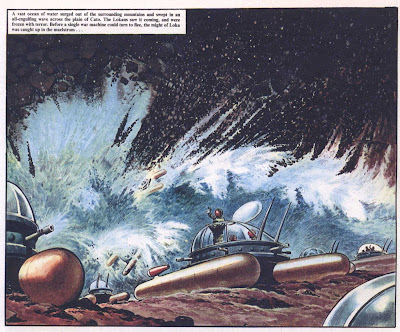Marvel, 2014
'Deathlok the Demolisher: The Complete Collection' is a 368 pp, full color trade paperback published by Marvel comics in 2014. It contains the full run of Deathlok stories published in Astonishing Tales, as well as other Deathlok appearances in comics such as Marvel Team Up and Captain America in the 70s and 80s.
The Deathlok character debuted in issue 25 of Astonishing Tales, August 1974. I've posted the content of that first issue here.
Creator Rich Buckler claims to have had the concept of a cyborg superhero in mind well before the March, 1973 debut of the TV series 'The Six Million Dollar Man'. Be that as it may, cyborgs were very much a 70s 'in' thing, and were embedded in the pop culture consciousness well before 1984 and the release of 'The Terminator'.
When I read the first few installments of the Deathlok character back in 1974, I was impressed: here was an offbeat antihero who freely killed people - innocent people - as part of his programming as a mercenary in the employ of a high-tech cabal.
Throw in the fact that the Deathlok storyline was set in a devastated New York city of the future (i.e., 1990) where homicidal cannibals lurked among the ruins, and you had a downbeat, dystopian view of the superhero comic........something new and unexpected in comic books at that time.
The novelty of having an 'antihero' who not only wielded a gun (a rarity for superheroes in the Bronze Age when the Comics Code still dictated content), but routinely used it to kill people, obscured some faults with the comic that now are quite apparent when viewed 42 years later.
For one thing, the Marvel comics of the 70s were very over-written, and Buckler and Doug Moench, the main writers for the Deathlok episodes, were no exception to the trend. The main plot simply gets more incoherent and contrived with each episode, until it's better off to simply ignore it....
But the Astonishing Tales episodes were particularly hampered by the inclusion of not just speech balloons, but the additional placement of both monologue text boxes for Deathlok....and the computer that has been installed in his brain (which expresses itself in 'checkbook' font). This means that practically every panel in the Deathlok comics is burdened with all of this text:
Add the fact that the main story in Astonishing Tales was often allotted only 16 pages - an established policy at Marvel in the early to mid-70s, when the company's burgeoning output exceeded its staff's ability to manage - and the plots simply try to do too much with too small a page count.
At the time he illustrated the Astonishing Tales run, lead artist Rich Buckler was carrying a heavy workload at Marvel, as he was also illustrating The Fantastic Four. By and large his work on the Deathlok character was reasonably good, although there are more than a few panels where it's apparent he was cutting some corners.
Those few fight sequences that aren't overloaded with text are very good:
After his initial run in Astonishing Tales, Deathlok was put out to pasture, one of the large cast of Marvel characters who were created during the 'anything goes', freewheeling atmosphere in the company's editorial offices during the 70s.
These episodes are competent, if not overly impressive, and usually involved some sort of throwaway 'time-travel' angle in order to have Deathlok meet up with one or another of the showcased Marvel heroes.
Deathlok's guest-star appearance in Marvel Two-In-One No. 27 (May 1977) as an unwilling assassin is a quintessential 70s comic, featuring President Jimmy Carter, the Fantastic Four, and even Nick Fury....
Probably the best of these 'guest star' appearances was the three-issue storyline in Captain America, issue 286 - 288 (October 1983 - December 1983). This time Luther Manning travels back in time to 1983, where he tells Captain America that - in what may be the future, or perhaps an alternate future - all superheroes have been eliminated.
A skeptical Captain America travels forward in time to 1993, to discover that Deathlok may in fact be right....
The inclusion of these Captain America episodes ends the overall anthology on a reasonably high note.
The verdict ? If you're willing to overlook the flaws with the constant monologues that detail Luther Manning / Deathlok's all-encompassing sense of self-loathing, the increasingly unconvincing plots, and the perfunctory nature of some of the character's guest star appearances, these comics still retain a strong, unique sense of a 70s - style dystopia that prefigures not just the whole cyborg phenomenon, but also such pop culture touchstones as Escape from New York. So in that sense it's worth picking up, especially since used copies in good condition can be purchased for under $20.














































































